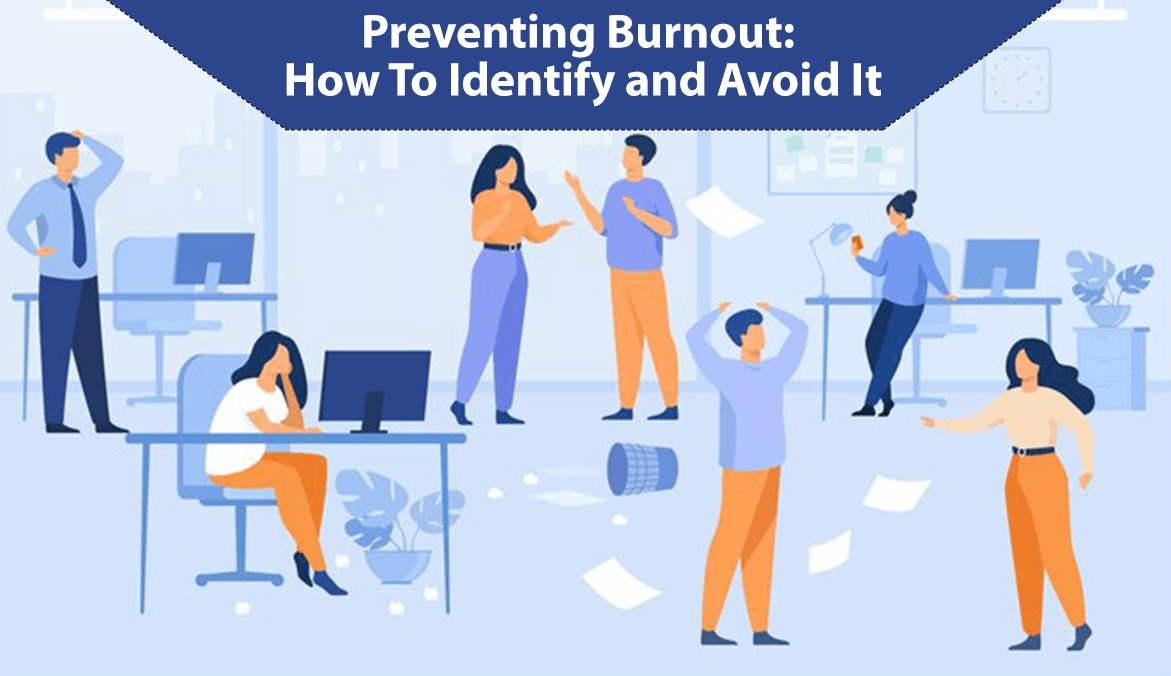In today’s fast-paced corporate world, burnout has become an all-too-familiar phenomenon. With the rise of remote work, constant connectivity, and a culture that often equates productivity with self-worth, it’s no surprise that many professionals are feeling overwhelmed and exhausted. According to a 2023 report by the World Health Organization, burnout affects up to 40% of employees in high-stress industries. This statistic highlights a pressing issue that organizations and individuals alike must address to foster a healthier, more balanced work environment. Understanding how to identify and preventing burnout is crucial for leading a balanced and fulfilling life.
What is Burnout?
Burnout is characterized by emotional exhaustion, depersonalization, and a diminished sense of personal accomplishment. It’s not just about feeling tired after a long day; it’s a state of chronic stress that can lead to physical and mental health problems, including anxiety, depression, and chronic fatigue. When left unaddressed, burnout can significantly impact job performance and personal well-being.
Burnout is defined as the condition of a person being physically and emotionally tired after having performed a difficult job for a long time. Burnout is a state of emotional, mental, and often physical exhaustion brought on by prolonged or repeated stress. Though it’s most often caused by problems at work. It is characterized by three dimensions:
- Feelings of energy depletion or exhaustion.
- Increased mental distance from one’s job, or feelings of negativism or cynicism related to one’s job.
- Reduced professional efficacy
Causes of Burnout
Burnout is often caused by a combination of factors, including excessive workload, lack of control, insufficient rewards, and lack of community. Recognizing these causes is crucial to preventing burnout.
Excessive workload: Too much work, long hours, and unrealistic expectations can lead to burnout. When you have a workload that matches your capacity, you can effectively get your work done, have opportunities for rest and recovery, and find time for professional growth and development. When you chronically feel overloaded, these opportunities to restore balance don’t exist.
To address the stress of your workload, assess how well you’re doing in these key areas: planning your workload, prioritizing your work, delegating tasks, saying no, and letting go of perfectionism. If you haven’t been doing one or more of these things, try to make progress in these time management skill areas
Lack of control: Micromanaging, lack of autonomy, and inability to make decisions is also a cause of burnout. Micromanagement can lead to feelings of mistrust, lack of autonomy, and a decrease in job satisfaction. Employees may feel like they are not trusted to do their job, which can lead to a lack of motivation and engagement. When employees are not given the freedom to make decisions and take ownership of their work, it can lead to feelings of disempowerment and lack of control.
Insufficient rewards: Inadequate reward and recognition means there is an imbalance between the effort workers put in and the recognition or reward they get. Recognition ideas such as gifts, bonuses, extra vacation days, or verbal appreciation can all be used to show employees that their efforts are being rewarded. A recognition example can take many forms, such as a public announcement in the form of an award ceremony or simply thanking individual employees for their contributions. Effective employee recognition and rewards can significantly improve employee engagement, resulting in higher productivity, better job performance, and increased company loyalty.
Lack of community: Poor social support, isolation, and feeling disconnected from colleagues and friends s can also cause burnout. People are social creatures, and lacking support and contact with others can contribute to loneliness, cognitive decline, anxiety, and depression. Finding a satisfying balance between much-needed recharge time and connecting with others is essential to one’s mental well-being.
Identifying Burnout Risks
Emotional Symptoms
- Lack of motivation: Not feeling interested and disconnected from activities that once brought joy and enthusiasm.
- Irritability: Get hyper, frustrated and annoyed, even over small things.
- Feelings of hopelessness: Feeling trapped and despairing, with no sense of a better future.
- Apathy: Showing no emotion or interest, even in important matters.
- Nervousness: Feeling anxious and on edge, with physical symptoms like rapid heartbeat.
- Difficulty concentrating: Struggling to focus and pay attention, even on simple tasks.
- Irrational anger: Experiencing intense, uncontrollable anger, often without a clear reason.
- Increased cynicism or pessimism: Expecting the worst and doubting the goodness of others.
- Sense of dread: Feeling a persistent, looming fear or apprehension.
- Depression: Experiencing a deep, prolonged sadness that affects daily life and relationships.
Physical symptoms
- Physical fatigue: Feeling extremely tired or exhausted, even after rest and sleep.
- Hypercholesterolemia: Having high levels of cholesterol in the blood, increasing the risk of heart disease.
- Type 2 diabetes mellitus: A chronic condition characterized by high blood sugar levels, insulin resistance, and impaired insulin secretion.
- Coronary heart disease: A condition where the heart’s blood vessels become narrowed or blocked, leading to heart attacks or strokes.
- Musculoskeletal pain: Experiencing pain or discomfort in the muscles, bones, or joints, affecting movement and mobility.
- Feeling exhausted: Feeling winded even when sitting still.
- Unable to recover from a common cold: Taking longer than usual to recover from a cold or flu.
- Frequent headaches: Experiencing recurring and persistent headaches, often with no clear cause.
- Frequent gastrointestinal problems: Having recurring issues with digestion, such as bloating, cramps, or diarrhea.
- Sleep disturbances: Having difficulty falling or staying asleep, leading to fatigue and other issues.
- Shortness of breath: Experiencing difficulty breathing or feeling winded even when doing simple tasks.
- Change in appetite: Noticing a significant increase or decrease in hunger, leading to weight changes.
- Trouble sleeping: Struggling to fall asleep, stay asleep, or getting quality sleep.
Behavioural symptoms
- Irritability: Experiencing increased frustration and annoyance, even over small things.
- Heightened emotional responses: Reacting excessively to situations, such as sudden tears or anger. (quick to cry, quick to anger)
- Suspicious and paranoid about colleagues: Distrusting and assuming negative intentions from coworkers without evidence.
- Substance abuse: Using drugs or alcohol excessively, leading to negative impacts on life and work.
- Stubbornness: Refusing to consider alternative perspectives or change one’s mindset. Rigid thinking, and unwillingness to listen to other people
- Negative attitude: Displaying a persistently pessimistic outlook, affecting relationships and work performance.
- Appears depressed: Showing visible signs of depression, such as sadness, disinterest, or hopelessness.
Effective Strategies to Prevent Burnout
Establishing clear work hours and avoiding overtime:-
Set a standard schedule and stick to it- Avoid checking work emails or taking work calls outside of work hours
– Learn to say “no” to excessive workload or overtime requests
– Take regular breaks throughout the day
– Establish a clear separation between work and personal life
Creating a healthy commute and workspace:-
Optimize your daily commute to reduce stress and increase productivity (e.g., listen to music, podcasts, or audiobooks)- Create an ergonomic and comfortable workspace
– Incorporate natural light and plants into your workspace
– Minimize clutter and distractions
– Consider flexible work arrangements (e.g., telecommuting, flexible hours)
Setting technology boundaries:-
Establish specific times for checking work emails or notifications- Turn off notifications outside of work hours
– Use website blockers or productivity apps to minimize distractions
– Set boundaries around social media use
– Prioritize face-to-face interactions and phone calls over digital communication
Prioritizing Self-Care:
– Schedule time for activities that bring joy and relaxation (e.g., exercise, hobbies, meditation)- Practice mindfulness and self-compassion
– Connect with friends, family, or a therapist for support
– Get enough sleep (7-9 hours for adults)
– Engage in activities that promote physical and mental well-being
Effective Time Management:-
Use a planner, calendar, or app to stay organized and focused- Prioritize tasks based on importance and deadlines
– Break tasks into smaller, manageable chunks
– Avoid multitasking and minimize distractions
– Take regular breaks to recharge and maintain productivity
- Time tracking app is one of the best ways to reduce overtime because it accurately captures and records employee work hours.
- A good workspace provides plenty of space to disperse your work and set up any necessary equipment, including a computer, keyboard and monitor.
- Sustainable commuting not only benefits the environment but also promotes individual well-being. Ensure that your seat supports your lower back, and your feet can comfortably reach the floor or pedals.
- Leveraging technology to plan the most efficient commuting routes can save time and reduce stress. the journey to and from work can significantly contribute to your physical and mental health.
Organizational Strategies for Burnout Prevention
Encouraging work-life balance policies:
– Offer flexible work arrangements (telecommuting, flexible hours, compressed workweeks) – Provide paid time off and ensure employees use their leave – Encourage employees to disconnect from work-related tasks outside of work hours – Support caregiving responsibilities (parental leave, eldercare resources) – Foster a culture that values work-life balanceProviding employee wellness programs and resources:
– Offer access to mental health resources (Employee Assistance Programs, counseling)- Provide physical wellness initiatives (fitness classes, on-site gym, healthy snacks) – Support financial wellness (financial planning resources, retirement plans) – Encourage social connections and community building – Offer resources for managing stress and burnoutFostering open communication and feedback:
– Regularly solicit employee feedback and concerns- Encourage open dialogue between employees and management – Foster a culture of psychological safety and trust – Provide clear expectations and goals – Recognize and reward employees for their contributions
Final Thoughts
FAQs
When stress becomes excessive, we mean that it is more than we can realistically handle. This type of stress can be traumatic, or can shake our experience of the world and ourselves. Prolonged stress is defined by an experience of stress where we do not have a chance to feel calm between stressors. Excessive and prolonged stress are often both present in burnout. Additionally, what is excessive and prolonged to one person may be different for another person.
No, burnout is not reserved for the bad times. It has happened to many business owners while their company performance was at its peak. Whether you're experiencing prolonged and excessive stress because your business or company isn't doing well, or because it is doing so well that you're afraid of slipping up, your body and mind lack rest.
Recognizing signs of stress, taking time out for yourself, trying new exercise routines, staying connected and making new friends, seeing problems from a different perspective, actively seeking expert help, and talking to professionals if stress takes over your well-being are the 7 steps for reducing and managing stress.
 Gift Card ₹999
Gift Card ₹999


